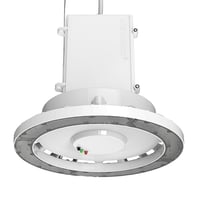 Safety is paramount in any facility. But when you’re open to the public, it becomes even more crucial. One of the most important aspects of safety is emergency lighting. It serves as a beacon during critical moments, ensuring a safe and swift egress in case of power failures or emergencies.
Safety is paramount in any facility. But when you’re open to the public, it becomes even more crucial. One of the most important aspects of safety is emergency lighting. It serves as a beacon during critical moments, ensuring a safe and swift egress in case of power failures or emergencies.
Regulations governing emergency lighting, such as NFPA 100 and NEC, provide a comprehensive framework to safeguard lives. Below, we’ll delve into the specific requirements outlined in these codes and highlight everything you’ll need to know about your emergency lighting to prepare for 2024.
What Is Emergency Lighting?
According to the Lighting Controls Association, emergency lighting is “emergency power source-supplied lighting that automatically energizes when there is loss of power to the building or lighting circuit.”
That sounds pretty straightforward, but there are complications: It’s subject to various safety ratings and codes, which are up to interpretation by the authority with jurisdiction (typically represented by the code inspector). As a result, builders and installers tend toward a conservative approach, which inspectors are less likely to find fault with.
Types of Emergency Lighting
There are two types of emergency lighting.
- Maintained: Maintained emergency lights are connected to the main electrical supply. They’re used in both daily operations and power outages. During power failures, connected batteries keep the lights on.
- Non-Maintained: These types of emergency lights are only activated during emergencies. They use backup batteries as a source of power.
Specific Requirements Regarding Egress Illumination
The main purpose of emergency lighting is to safely guide people out of a space in an emergency, like a fire, earthquake, or other natural disaster.
Codes such as National Fire Protection Association (NFPA) 101 Life Safety Code (7.8, 7.9, 7.10) dictate the standards for egress illumination. International codes include the International Energy Conservation Code (IECC) and the International Building Code (IBC) Chapter 10-1008, 1013. These standards cover various areas, including exit discharges, electrical equipment rooms, and fire command centers.
Sensor-equipped fixtures are also addressed in NFPA 101 (7.8.1.2.2), requiring automatic, motion sensor-controlled lighting within egress paths. Fail-safe modes and specified delays are essential to guarantee uninterrupted illumination during power transitions.
Stairway and Walking Surfaces
Stairways have their own set of requirements (NFPA 101 7.8.1.3). The minimum illumination for new stairways is 10 foot-candles, a standard designed to ensure optimal visibility and minimize trip hazards.
Emergency Egress Illumination: Duration, Minimums
Emergency egress illumination must last a minimum of 90 minutes (NFPA 7.9.2.1 / IBC Ch. 10-1008.3.4). Specific illumination levels are mandated, ranging from one foot-candle on floors and walking surfaces to 10 foot-candles in stairwells. Storm shelters have an extended requirement of 120 minutes.
Testing
Regular testing of emergency lighting is crucial for its reliability. NFPA 101 (7.9.3) outlines three acceptable methods for periodic testing. These methods include functional (manual) testing, involving a 3-second activation, as well as onboard self-testing/self-diagnostics with a monthly 30-second test and an annual 90-minute drain and recharge. Computer-based self-testing/self-diagnostics is also recommended to ensure the ongoing effectiveness of emergency lighting systems.
What’s Coming: Emergency Lighting Code Changes in 2024
Emergency lighting codes change regularly. They’re evaluated every other year and include foot candle requirements, testing specifications, and specific requirements for different spaces, like stairwells and storm shelters. Below is the update schedule.
IECC: Since it was last updated in 2021, The IECC Board of Directors recently voted to shift from a codes process to a standards process. Instead of ICC Governmental Members voting, Residential and Commercial Consensus Committees now develop the content for inclusion in the 2024 IECC. The content is currently under review.
IBC: 2024 update has already been released.
NFPA: 2024 edition has already been released.
NEC: Updated in 2023. The next update is set for 2026.
Normally, these codes have public discussion periods before changes are adopted. Keeping tabs on the websites of each of these governing bodies before and after the codes are adopted will help you see what changes are coming in 2024 and beyond, so you can stay compliant.
Adoption of the codes can vary based on municipalities, counties, and states. But the state level mandates are the standard that no municipality or county can go below. So, while your facility may not have yet adopted the latest standards, it’s best to know and implement them as soon as they go into effect at the state level.
Features and Functionalities in 2024
Beyond regulatory compliance, it's crucial to explore additional features and functionalities required for emergency lighting in 2024. Insights from customers, especially regarding their unique needs, can give you important insights into how your emergency lighting should function. Knowing the space and who uses it is vital to making sure your emergency lighting is tailored to specific environments.
Beyond Traditional Emergency Lighting
In 2024, heightened awareness from installers is also important. While many lighting installers are well-versed in codes and the principles of egress paths, there is a critical aspect that may escape their attention: the lighting over exit doors. Understanding whether this lighting needs to be connected is pivotal. Specifically, the fixture outside the exit door must be linked to the battery powering the adjacent interior light.
Installers need to be fully aware of these nuanced configuration requirements to ensure the seamless integration and functionality of emergency lighting systems.
 Product spotlight: LED Emergency Lights for High Ceilings
Product spotlight: LED Emergency Lights for High CeilingsThe safety-focused LED Emergency Light is the first of its kind designed specifically for high bay applications.

Another change to look for in 2024 is improvements in technology. While traditional bug-eye fixtures have their place, understanding their limitations is crucial.
Modifications, partitions, and renovations, for instance, may result in shadows that call for supplementary lighting fixtures to maintain adequate illumination levels. Large warehouses, in particular, may benefit from standalone emergency fixtures strategically placed along egress paths. In these situations, a bug-eye fixture may not provide enough emergency illumination to help someone safely exit the building if normal power is lost. Most codes specify it must illuminate the area several feet away from the building for that circumstance.
Compatibility with Technology
Another technological change that will affect emergency lighting in 2024 is advancements in smart technology.
Connection to emergency batteries and compatibility with apps like LiteSmart allows for remote monitoring and notifications. This can give you timely and important insights into the status of your emergency lighting system. It can also potentially influence insurance considerations.
The landscape of emergency lighting is evolving to meet the demands of 2024 and beyond. To make sure your facility is ready, it’s crucial to stay informed about codes, embrace technological advancements, and prioritize compliance. As we navigate towards a safer and technologically advanced future, a thorough understanding of regulations and a commitment to innovation will be key in enhancing emergency lighting systems across various facilities.
Need help choosing the right emergency lighting for your project? Our Lighting Design Tool has you covered.

